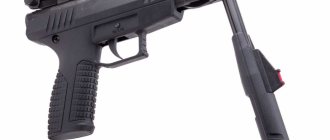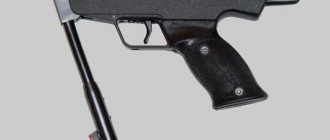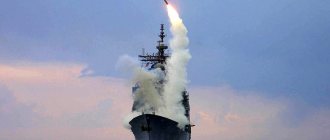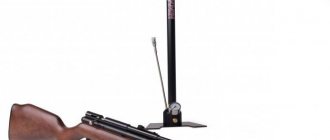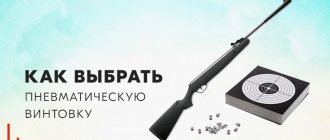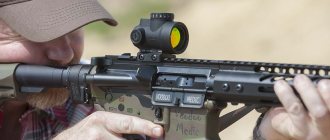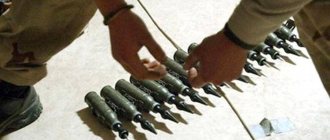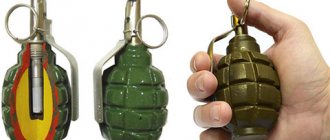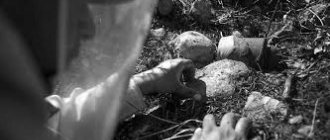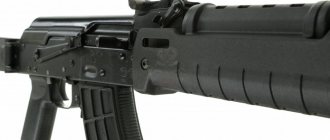What is spring-piston pneumatics
Spring-piston pneumatics are a type of weapon that ejects a bullet using a spring or compressed gas. Germany is considered to be the birthplace of pneumatics, where the inventor was the gunsmith Gutter.
People often call the PPP “fracture” because of the type of platoon that is inherent in most models. The legislation of the Russian Federation indicates that any pistol with a power of less than 7.5 Joules is a tool for entertainment or training in shooting, but not a full-fledged weapon, and therefore is on free sale. Only pistols over 7.5 Joules require special permission to purchase.
Several types of projectiles are used for shooting, which are intended for certain models. The age restriction (purchase is only possible for adults) applies only to the Flaubert cartridge.
Pneumatics have types, divided according to the method of initial compression. There are three modern mechanisms that are suitable for pneumatic operation:
- Pneumatics RSR. Air must first be pumped into the gun’s containers using a compressor or manually.
- Pneumatics with carbon dioxide. The gun is charged with special cylinders filled with CO2.
- Spring-piston system. Equipped with a spring that moves the piston, thereby charging the gun with air, filling the freed up space. The spring can be metal or gas
The only weak point of the PPP is the spring that tensions the piston. Frequent use or improper storage can cause rapid wear of the part. Therefore, a metal spring is often replaced with a more expensive gas spring.
Principle of operation
The spring-piston system is simple to implement and reliable. Unlike a gas gun, the spring-powered model does not have a reservoir or cylinder of compressed gas. However, it is the pressurized air that pushes the bullet out of the barrel.
The spring-piston design consists of a spring, a piston and an empty cylinder connected to a barrel. Of course, air freely penetrates inside. The spring is compressed before firing. This occurs while cocking or loading the pistol with a bullet.
When the trigger is pressed, the previously compressed spring straightens, begins to move, and pushes the piston. As a result of this movement, the air inside the cylinder is compressed. His blood pressure increases. The air flow moves into the barrel and pushes the projectile out, overcoming the friction force. The bullet flies out at a speed of 100-350 m/s.
Important! Some spring-piston pistols operate without a cylinder, but on a gas spring. Such modifications are characterized by weaker output, but stable power.
Operating principle of spring-piston pneumatics
The principle of operation of the PPP is the simplest and most reliable compared to analog types of pneumatics. They do not have a valve system and there is no container for compressed air. The cylinder is completely adjacent to the barrel. When the gun is cocked, the piston compresses the spring, preparing the gun to fire. The piston will hold until the trigger is engaged.
When the trigger mechanism is activated, the piston returns to its standard position with high kinetic energy under the elasticity of the spring. The piston itself compresses the air between the piston and the bullet, thereby pushing the bullet out of the barrel.
There is a type of complicated design, where inside the air cylinder there is a movable glass, which has a hole in the bottom, with a piston inside. When the lever of such a pistol is cocked, the glass and piston move back, thereby opening the charging window. In this way, the piston is also installed in the firing position using spring tension. When a bullet is placed in the charging window, the erection lever returns to its original position, thereby returning the cup. When a shot is fired, the mainspring moves the piston, which compresses the air, pushing the bullet out of the barrel.
SPPs can consistently produce shots of equal strength. But the number of repetitions is limited, it will depend on the physical aging of the spring that pushes the piston. The only way to avoid wear is to use gas springs instead of metal ones. The firing effect will be identical, since the piston will be pushed out by air. The cost of such weapons is higher than those using metal springs. The advantages of gas spring guns are: quiet operation, low recoil, high accuracy.
PPPs that use gas springs are distinguished by the quietest shot sound. The reason is the absence of a metal spring, which makes rattling noise when straightened. The shot power can exceed 380 m/s.
IPPs that use a metal spring have high recoil, which is especially noticeable in powerful models where the bullet speed exceeds 280 m/s. There is also a high noise from the shot.
Selection rules
Most air guns are powered by gas power. The gas, coming out of the cylinder or reservoir, pushes the bullet out of the barrel and sends the next projectile out of the magazine. Semi-automatic pneumatics allow you to shoot in short bursts and not be distracted by loading the weapon. However, all gas modifications depend on the gas content of the tank or cylinder. As these containers are discharged, the power of the shot decreases.
But pneumatics running on compressed gas have the highest bullet ejection speed and muzzle energy. The power of some gas pistols reaches 25 J. Of course, you won’t be able to buy a powerful weapon without special permission. Only 4.5 mm caliber pneumatic guns with muzzle energy from 3 to 7.5 J are sold without certificates and licenses.
Spring-piston models have low power and penetrating force. But such pneumatics do not depend on the filling of the gas cylinder. Spring guns always work the same way. The energy source does not affect the power of the shot; it is constant throughout the entire period of operation of the weapon.
And spring-piston models are cheaper than their gas counterparts. Any person over 18 years of age can buy spring pneumatics.
Domestic models of spring-piston pneumatic pistols
The only domestic PPP model that deserves attention is the Baikal MP-53M or Izh-53, ideal for sport shooting. The Izhevsk Arms Factory donated a large number of high-quality firearms, which are valued all over the world. The same thing happened with the Izh-53, which can often be found in the arsenal of riflemen.
Popularity among sports shooters prompted manufacturers to create three modifications that differ in their configuration and power. If the cheapest model costs 2900, then the price for the richest configuration will exceed 7000 rubles. The expensive version will include not only a pistol, but also additional elements that will be required when shooting: targets, additional magazines, springs and gas cylinders.
Air rifles with a broken barrel
About them quite briefly, since this type is widely known from the Soviet Tirov “ovens”. Although recently, even in such a conservative segment as spring-piston “fractures”, completely unique designs have also emerged. Some of them are described in the article “Unusual pneumatics: two calibers in one rifle.”
The actual loading process looks very simple: we break the barrel, the cocking rod moves the piston in the cylinder until it is cocked, held by a hook. Then we insert the bullet and return the barrel to its working position.
Pay attention to your left hand. If you neglect the retention, then if the piston is likely to fall off the hook, it is quite possible to get a broken coupling, the so-called “banana”, that is, a barrel bent upward (photo below), in especially sad cases, even with this same barrel on the forehead.
* * *
Contrary to popular belief, “perelokki” are practically no different in accuracy from rifles with a fixed barrel. A much larger role is played by the engineering elaboration of the entire structure and the quality of workmanship.
For example, the force of a heavy-duty spring may not correspond to the bypass characteristics or even the caliber of an airgun (see “Powerful Airguns: Hatsan mod 135”). The result is an unbalanced rifle with terrible accuracy and, funnily enough, reduced bullet velocity. Or, if the design of the fracture unit is unsuccessful, the bypass seal - a rubber or polymer ring on the end of the cylinder or barrel coupling (pictured below) - may become jammed or even cut off when closing.
In the above photograph, a detail is clearly visible that characterizes one of the fundamental differences in the barrel locking design of break rifles - a spring-loaded ball through a tooth. The second option is a spring-loaded bolt (in the photo below - under the barrel in the coupling) through a transverse pin or a fixed bolt.
If the sharpening angles of the bolt are unsuccessful, breaking and locking the barrel requires too much effort. Or the barrel, on the contrary, is poorly kept in a locked state. It’s these kinds of “little things” that often plague the designs of spring-piston pneumatics in the budget segment.
Spring-piston pistols from foreign manufacturers
Foreign manufacturers offer a much larger range of PPPs. A large selection will allow you to find a suitable shooter model based on cost and characteristics.
Blow H-01
Primarily used as a starting pistol for sport shooting. To ensure maximum accuracy, it has a recoil system that allows you to suppress recoil after a shot. The anatomical grip allows the pistol to fit perfectly in the hand. Can be equipped with a sight with an anti-reflective mount. Platooning is carried out by breaking the barrel.
All you need for shooting is 4.5 mm lead bullets. After long use, it will be necessary to replace the springs, which wear out during operation, which will affect the force of the shot, which on standard springs is 120 m/s. The base of the gun is made of steel, which ensures high strength. In this case, the weight of the PPP does not exceed 1 kg. To reduce the cost of the model, plastic is used in the anti-slip handle.
Gamo P-900
The Spanish manufacturer created the P-900 model primarily for practicing aimed shooting. The model is perfect for those who want to regularly practice shooting to get good results. It can be loaded with four types of ammunition:
- Dart.
- Lead balls.
- Steel balls.
- Pointed lead bullets.
Most of the elements are made of plastic, which explains the lightness of the pistol (560 grams). Low power does not affect shooting accuracy due to the elongated rifled barrel. Accuracy is maintained at a distance of 15 meters.
Daisy Powerline 340
The model has a lightweight design (weights only 320 grams), making it ideal for shooting practice for beginners, children and teenagers. An additional factor influencing the popularity of Powerline 340 is the low price of PPP - from 2000 rubles. The ergonomics and appearance of the original firearm have been preserved. Only 4.5 mm explosive balls are used as ammunition.
The store consists of two compartments: a container and a feeder. The feeder holds 13 bullets, and the container holds 200.
The shot power is no more than 3 Joules, which allows you to send a bullet from the muzzle at a speed of 74 m/s. When purchasing, it is worth remembering that there are no rifling inside the barrel. This negatively affects the accuracy of shooting.
The element that replicates the fuse is a decorative detail. There is no possibility of adjusting the sight. After each shot, it is necessary to feed the bullet using the bolt.
Choosing a pistol for sport shooting
It is necessary to pay attention to the power and accuracy of shooting. If beginners can limit themselves to budget models for 2000-4000 rubles (for example, Izh-53), then for high-level shooting they will need to choose PPP from the highest price segment. Examples of good pistols for professional shooting are the Diana LP 8 Magnum and the Hatsan Mod 25 Supercharger.
Both models cost more than 12,000 rubles, but they allow you to make accurate shots at long distances thanks to the power and long barrel with threads along the entire length.
Choosing a Pistol for Fun
Not every pistol you purchase will be used for professional shooting. In most cases, IFR is used for shooting with friends. Then it is best to choose lightweight models that allow mechanical delivery of the bullet.
Crosman PSM45
The best examples are the Daisy Powerline 340 and Crosman PSM45, which have similar characteristics and are equipped with a magazine. In most cases, Powerline 340 is preferred due to its low cost.
How much does PPP cost?
| Model | Short description | price, rub. |
| BLOW H-01 | A classic shooting model that is perfect for beginners. The accuracy and accuracy of shooting is due to the rifled barrel. The model belongs to the budget category. Therefore, the pistol has a plastic handle, which has a positive effect on its weight. Bullet speed from 120 m/s. | 3300 |
| Daisy PowerLine 340 | Lightweight model designed for teenagers. Almost all of it is made of plastic. The bunker can hold up to 200 units of ammunition. The pistol has low power, and the bullet speed is no more than 74 m/s. | 2000 |
| Hatsan Mod 25 Supercharger | A powerful and expensive model from the Turkish company Hatsan, whose main focus is the development of firearms and pneumatic weapons. The model has a recoil damping system. Due to the large amount of metal, the weight of the model is 1700 kg. Shot speed is about 215 m/s. | 13000 |
| Baikal MP-53M or Izh-53 | The manufacturer is the Izhevsk Arms Plant. A classic option for beginner shooters. Performs its job consistently under almost any conditions. All metal elements are treated with oxidation. Projectile speed 110 m/s. | 2900 |
| Gamo P-900 | The pistol comes from Spain. The main purpose is shooting training. Can shoot darts, lead balls and lead bullets. The weight of the pistol (560 grams) allows it to be used by teenagers and women. The bullet speed reaches 105 /s. | 4000 |
| Strike One B015 | An inexpensive model that is loaded exclusively with lead bullets. The handle is made of wood, and the bolt and base are made of a metal alloy. As standard, the pistol is equipped with a weak spring, which allows you to fire a bullet at a speed of 130 m/s. But it is possible to replace the spring with a more powerful one. Then the projectile speed will increase to 170 m/s. | 2600 |
| Crosman Benjamin Trail NP | A classic pistol that uses gas spring technology that is pushed by nitrogen. This has a positive effect on the silence and impact of the PPP. Shooting can be carried out in any weather. Maximum bullet speed is 152 m/s. Suitable not only for a professional, but also for a beginner. | 8000 |
| Umarex Browning Buck Mark URX | An inexpensive model from a German manufacturer, with a rifled barrel for accuracy of shots. The main target audience is beginners in shooting, who will find it easy to handle the pistol due to its low weight (680 grams). For ease of use by children and adolescents, the PPP is equipped with an automatic fuse. | 5000 |
| Diana LP 8 Magnum | One of the best PPP models. Attracts buyers due to the ratio of price and high quality. Shoots standard 4.5 mm caliber bullets that reach speeds of up to 170 m/s. The weapon is well balanced and can be equipped with an optical sight. | 22500 |
| Crosman PSM45 | The model was developed in America, but assembled in Taiwan. Charges exclusively with 4.5 mm explosive balls. Has a magazine with a capacity of 20 ammunition. It has low power (3 J) and low shot speed of 60 m/s. Accuracy of fire is achieved not due to the threads in the barrel, but due to its length. | 8800 |
To choose a suitable pistol, you need to take into account the technical characteristics of the weapon. They are the ones who determine the behavior of the PPP when shooting. Additionally, you should pay attention to models from famous manufacturers that are famous for their build quality.
The most powerful air pistols
Pneumatics can be used as an improvised means for self-defense. True, this kind of pistol does not belong to the category of “firearms”; it cannot kill a person.
"Hatsan" - AT-R2
Pneumatics from Turkish manufacturer Hatsan. Externally, the model is more similar to a rifle (carbine). Used for sports and training at the shooting range.
Main characteristics:
- 4.5 mm caliber;
- 7.5 J (power);
- PCP (pre-pumping);
- multi-charged;
- 35 shots per fill;
- biathlon platoon;
- for lead bullets;
- magazine for 10 shells;
- 264 m/s (initial bullet speed);
- up to 3 kg (weight);
- 64 cm (total length);
- $500 (price).
Pros:
- dovetail mount for optical sight;
- fuse;
- average penetration force;
- sold without a license.
Minuses:
- too bulky design;
- high price.
ATAMAN AP16
The Russian air pistol "Ataman AR16" is considered the most powerful pneumatic gun in the world.
Outwardly, it is somewhat reminiscent of the Colt M1911. Air pistols "Ataman" are presented in two versions - 4.5 mm and 5.5 mm caliber. Low-power pneumatics can be purchased without permission.
Description:
- 5.5 mm caliber;
- 20 J (power);
- 220-280 m/s;
- on a compressed air cylinder (108 cm3);
- biathlon recharge;
- magazine for 6 shells;
- for lead bullets;
- weight about 1 kg;
- 600-700 dollars.
Advantages:
- guaranteed hit accuracy at a distance of up to 35 meters;
- average penetrating force.
Flaws:
- high price;
- need a license.
EDgun "Veles"
The pneumatic model of the Russian manufacturer EdGun looks like a firearm. Used for sport shooting and training.
Characteristics:
- 5.5 mm;
- 7.5 J;
- 210 m/s;
- PCP (high pressure tank);
- single shot;
- 900 grams;
- 30 cm long;
- for lead bullets;
- 30 shots per fill;
- $580.
Pros:
- good accuracy at short distances;
- sight mount;
- average penetrating force.
Minuses:
- single shooting;
- high price;
- need a license.
Crosman 1377
Pneumatics from the American brand Crosman. Suitable for sport shooting and training at the shooting range.
Description:
- 4.5 mm caliber;
- 3 J;
- multi-compression;
- PCP (compressed gas);
- for lead bullets;
- magazine for 1 shell;
- 183 m/s;
- 0.91 kg (weight);
- 34.6 cm (total length);
- 80 dollars.
Advantages:
- fuse;
- low cost.
Flaws:
- for single shooting;
- weak penetration force;
Gamo Killer Blowback
Pneumatics from the Spanish company Gamo with a Blowback system that simulates the recoil of military weapons. Outwardly it resembles a firearm. Suitable for training and sports activities.
Description:
- 4.5 mm caliber;
- 3 J;
- 138 m/s;
- gas cylinder;
- 12 g CO2 cylinder;
- one charge is enough for 60-80 shots;
- for lead bullets and steel explosive balls;
- magazine for 16 shells;
- weighs 700 grams;
- 120 dollars.
Pros:
- fuse;
- high hit accuracy at distances up to 35 meters;
- shooting with balls and lead bullets.
Minuses:
- the power of the shot depends on how full the can is;
- weak penetration force.
Crosman C31
The air pistol looks like a combat Beretta 92. It is used for training shooting at a shooting range or training ground.
Main characteristics:
- 4.5 mm caliber;
- 3 J;
- gas cylinder;
- 162 m/s;
- for steel balls;
- magazine for 18 shells;
- semi-automatic;
- 12 g CO2 cylinder for 60 shots;
- 680 grams (weight);
- 22.5 cm (total length);
- 50 dollars.
Advantages:
- low cost;
- multi-charge.
Flaws:
- shoots only balls;
- weak power.
Umarex Beretta 92FS
The pneumatics of the German company Umarex are reminiscent of the Beretta 92 FS military weapon. Suitable for sports and training shooting.
Main characteristics:
- 4.5 mm caliber;
- 3 J;
- 125 m/s;
- for lead bullets;
- magazine for 8 shells;
- 1.26 kg (weight);
- 21 cm (total length);
- gas bottled CO2;
- 125 m/s (bullet speed);
- $180 (cost).
Pros:
- multi-charge;
- good accuracy at short range.
Minuses:
- weak penetration force;
- heavy weight.
MR-654K PM
Pneumatics from the Russian manufacturer "IMZ". The model is similar in appearance to a Makarov pistol. Suitable for target practice.
Description:
- 4.5 mm caliber;
- 3 J;
- 115 m/s;
- gas cylinder (CO2);
- for steel explosive balls;
- magazine for 13 shells;
- 725 g (weight);
- 16.1 cm (total length);
- one 12 g cylinder for 60-70 shots;
- 120 dollars.
Advantages:
- multi-charge;
- economical consumption.
Flaws:
- weak penetration force;
- As the cylinder discharges, the power weakens.
ASG CZ P-09 Duty blowback
The air pistol of the Danish brand ASG looks like a combat weapon CZ P-09 Duty. Used for sports and training at the shooting range.
Main characteristics:
- 4.5 mm caliber;
- 3 J;
- 135-150 m/s;
- gas cylinder;
- 12 g CO2 cylinder;
- for lead bullets and steel balls;
- magazine for 16 shells;
- 0.7 kg (weight);
- 20.5 cm (total length);
- 150 dollars.
Pros:
- multi-charged;
- Weaver mount;
- 2 types of projectiles.
Minuses:
- weak stopping power;
- As it discharges, the power weakens.
"Ataman-M2"
The Russian manufacturer's pneumatics resemble the Italian Beretta 92FS in appearance. The compartment for cylinders is located in the upper part and imitates a large trunk. The model is intended for training shooting.
Description:
- 4.5 mm caliber;
- 3 J;
- 240 m/s;
- universal operating principle (gas cylinder + PCP);
- lead bullets;
- magazine for 20 shells;
- 25 cm;
- 750 grams;
- $178.
Advantages:
- operates from a 12 g CO2 cylinder and a compressed air tank;
- multi-charge.
Flaws:
- weak penetration force;
- not suitable for long-range aiming.
